|
Canon PowerShot D20
What is Canon's second waterproof, freeze proof and shockproof digital camera all about? To find out, we took it on a tough trip across the Sea of Cortez.
(by Conrad H. Blickenstorfer and Carol Cotton)
Canon, the leading digital camera manufacturer in the world, introduced its first waterproof camera in February of 2009, and the D10 turned out to be so good that as of July 2012 it's still in Canon's active lineup. That's three-plus years, an eternity in the digital camera market. Canon did, however, add a second model in February 2012, and it is the new Powershot D20 that we're taking a look at in this review. The D20, like the D10, is specifically designed to take the kind of abuse many cameras can reasonably expect in the hands of a boating, camping, hiking and just generally outdoorsy clientele. How does it compare to the original D10, and where does it stand with regard to its competition?
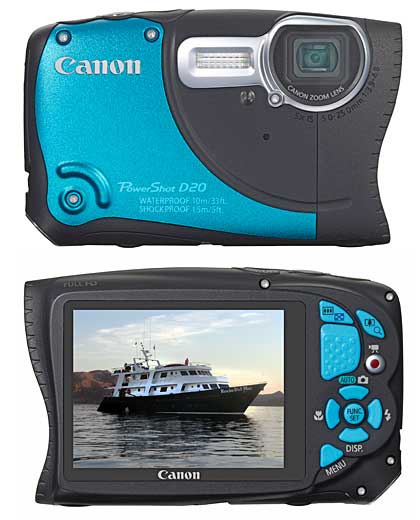
Why a waterproof/freezeproof/shockproof camera?
For a number of reasons. First, while Canon has been selling protective underwater cases for their cameras for years, those cases tend to be bulky and having a camera that is rugged and waterproof all by itself, without housing, is so much handier. Second, there is increasing competition in the market for tough, waterproof cameras, and Canon wants to have an iron in the fire. Third, compact digital cameras have become commodity items with very small profit margins, and higher-end compacts are probably more financially feasible. And fourth, with camera-equipped smartphones taking an ever larger bite out of the compact camera market pie, camera manufacturers are increasingly concentrating on things smartphone cameras can't do. Like being underwater.
As far as water and shock resistance go, anyone into boating, kayaking, surfing, fishing, snorkeling or just hanging out by the water knows that taking pictures around and in the water is a great experience. Being able to shoot pics by the pool or at a beach without having to worry about the camera getting wet is priceless. As far as freezeproof and shockproof go, that also comes in handy. Taking your camera skiing, snowboarding or hiking in the cold is a good thing. As is not having to worry about dropping it. Compact cameras are small and it's all too easy to have one slip out of your hand or pocket.
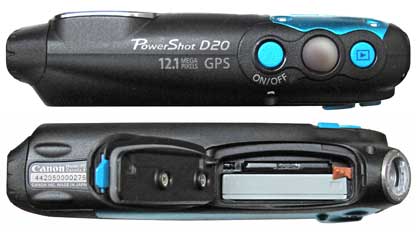
What does Canon offer with the PowerShot D20
Based on three years' worth of experience and user feedback from the initial waterproof PowerShot D10, Canon retained what worked and changed what didn't.
The biggest issue with the D10 was the bulky zoom lens that necessitated a big bulge that partially blocked the flash when shooting macro. The bulge is gone now, thanks to an internal folding zoom design. The second problem of the D10 was the pedestrian 3X zoom that started at 35mm instead of wide. The D20 fixes that with a 5X optical zoom that starts wide at 28mm and goes up to 140mm (35mm equivalence). The third D10 issue was its limitation to 640 x 480 pixel VGA video which even at the time was simply no longer enough. The new D20 has full 1080p video and is an overall much more competent vidcam. More minor criticisms were that the zoom worked backwards, and that there was only a single underwater mode. Canon addressed that, too. The zoom now works the way it should (i.e., right button zooms in, the left out), and there are now two underwater modes. Oh, and since flooding is the big enemy of underwater cameras, we criticized the somewhat flimsy battery compartment door. Fixed, too.
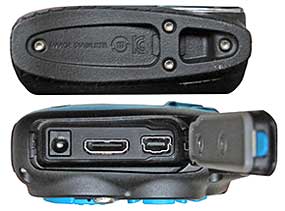 As far as resolution goes, the D20 remains a 12 megapixel camera just like the older D10, but it's using a CMOS imager instead of a CCD. The move to CMOS has been underway for a few years now, and it makes HD video and all sorts of video and still recording tricks possible. There is full optical image stabilization and the camera has all the features and goodies common to modern digital compacts, such as advanced face recognition, predefined shooting modes that the camera can select automatically, in-camera editing tricks, and so on. The bright wide viewing angle screen measures 3 inches diagonally now (the D10's is 2.5 inches), and the camera is equipped with Canon's advanced proprietary DIGIC 4 image processor (DIGIC stands for Digital Imaging Core) that offers excellent speed, good noise reduction in low-light condition, face recognition and more. As far as resolution goes, the D20 remains a 12 megapixel camera just like the older D10, but it's using a CMOS imager instead of a CCD. The move to CMOS has been underway for a few years now, and it makes HD video and all sorts of video and still recording tricks possible. There is full optical image stabilization and the camera has all the features and goodies common to modern digital compacts, such as advanced face recognition, predefined shooting modes that the camera can select automatically, in-camera editing tricks, and so on. The bright wide viewing angle screen measures 3 inches diagonally now (the D10's is 2.5 inches), and the camera is equipped with Canon's advanced proprietary DIGIC 4 image processor (DIGIC stands for Digital Imaging Core) that offers excellent speed, good noise reduction in low-light condition, face recognition and more.
What sets this increasingly popular breed of ruggedized cameras apart from standard compacts is that they can take a beating. The PowerShot D20 is waterproof to 33 feet, has an operating temperature range of 14 to 104 degrees Fahrenheit and is shockproof to five feet (up from four feet for the D10).
The D20 is a bit larger and heavier than it looks. It measures 4.4 x 2.8 inches and is 1.1 inches thick. It weighs in 8.3 ounces as tested, with the battery and memory card installed. That's all a bit more than the earlier D10.
In terms of looks, Canon apparently likes for its underwater cameras to stand out. The earlier D10 had a unique, rounded metallic-looking silver body. The D20 has a more angular black plastic body, albeit also with numerous curves. Metallic inserts in the front come in three colors (blue, yellow and gray), with color-matched plastic hardware controls.
Features
For several years, there's been a feature arms race in the digital camera market, but featuritis for the sake of it has abated somewhat now that even the most basic cameras have image stabilization, face recognition and numerous operating modes. Instead, the emphasis has moved to including genuine technological advances, and those have come in the form of better, larger LCD displays, the inclusion of HD video, much more powerful in-camera image processing, improved low-light capabilities, and merging GPS capabilities into cameras so that images can be tagged with geographic information.
The D20 does have integrated GPS. You can add location info (latitude, longitude and elevation) to still images and movies, you can create separate GPS log files that show where the camera has been, and you can even use GPS to update date and time automatically.
In terms of features, what has changed is that rather than overwhelm the user with endless options, the D20 seeks to take optimal pictures in any situation, while still giving the user the choice to manually intervene. This way, in automatic mode, the D20 actually picks from almost three dozen available modes to make the best of a situation. Image stabilization, likewise, is automatically applied. Canon calls it "intelligent IS," and the camera differentiates between half a dozen different stabilization modes and tries to apply the right one. There are still occasionally helpful gadget features such as blink detection and a wink or smile self-timer but by and large, the emphasis is on making the camera as easy to use as possible.
There are times when you know exactly what you'll be shooting, and for that the D20 has a number of specific scene modes, but it works a bit different from before. In addition to Auto, you can select Program mode, Underwater mode, Snow mode, iFrame or super slow motion video, and then a full 16 modes all selectable from one menu spot. They are:
- portrait
- smart shutter (shoots when it detects a smile)
- handheld night scene
- low light
- fish-eye effect (three levels)
- miniature effect (by blurring areas above the focus)
- toy camera (vignetting and blur)
- monochrome (b&w, sepia, blue and white)
- super vivid
- poster effect
- color accent (pick a color, rest is black and white)
- color swap (replace one color with another)
- fireworks
- long shutter (1-15 seconds)
- stitch assist (helps creating panoramas)
- movie digest (short movie of a full day)
Some of these modes are available both in stills and in video.
Since underwater color is especially tricky, white balance can be manually corrected in the two underwater modes. You can either manually evaluate the white balance by using something white underwater, or by correcting in eleven steps between more blue or more amber (thus approximating the effect of filters).
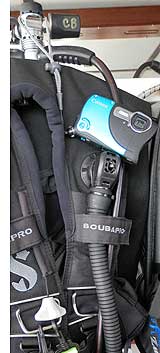 Having a CMOS sensor opened the way to adding advanced video capabilities in addition to HD. You can, for example, shoot at 120 frames per second in 640 x 480 VGA mode for a 4X perceived slow-down, or in 240 fps in 320 x 240 mode, for an 8X slow-down. Having a CMOS sensor opened the way to adding advanced video capabilities in addition to HD. You can, for example, shoot at 120 frames per second in 640 x 480 VGA mode for a 4X perceived slow-down, or in 240 fps in 320 x 240 mode, for an 8X slow-down.
In Program mode you have control over exposure compensation, metering (evaluative, center, spot), ISO, contrast, white balance, color tones, continuous shooting, and manual focus. There also is a digital tele-converter that multiplies the focal length by 1.5x (42-210mm) or 2.0x (56-280mm), making for steadier pics compared to standard zoom.
The D20's 3.0-inch LCD is pretty much standard size these days. It has twice the resolution of the D10's display and has a very wide viewing angle in any direction as well as special anti-reflective and scratch-resistant coating.
While many consumer cameras have tiny little buttons, the PowerShot D20 has large, grippy ones that are spaced far enough apart so the camera can even be operated with gloves. That comes in handy in the cold and when underwater.
Design and controls
Compared to the rather unique PowerShot D10 with its unique combination of playful (overall look and colors) and tough (some design elements and exposed industrial-looking screws), the D20 is more conventional and more logical. 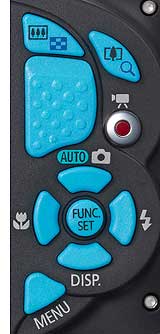 The folding internal zoom eliminates the D10's porthole-like bulge that interfered with macro flash. And instead of having large attachment ports on all four corners for a strap or karabiner, the D20 has just one. The curvy left side of the camera seems a little odd, but there's probably a reason for it. The folding internal zoom eliminates the D10's porthole-like bulge that interfered with macro flash. And instead of having large attachment ports on all four corners for a strap or karabiner, the D20 has just one. The curvy left side of the camera seems a little odd, but there's probably a reason for it.
The D20's controls are simple and mostly follow the current standard for digital cameras. On top are the shutter, the on/off button, and for playback. Video has its own recording button with a red dot on it. Red universally means "record," but divers know that the color red disappears at 15-20 feet of depth.
The back features the very nice 3.0-inch LCD, two separate zoom buttons, and DISP and MENU buttons. There is also a five-way navigation arrangement, with the "FUNC/SET" button in the middle, and four directional buttons each of which also brings up one of the common screen menus.
On the bottom, in addition to the self-locking storage card and power compartment cover, is a plastic-threaded tripod mount. On the right an also self-locking AV/mini-HDMI compartment.
Power
The PowerShot D20 uses the same small 3.7V Li-Ion NB-6L battery, though its capacity rose from 850 to 1,000mAH. A full charge is good for about 260 pictures or six hours of playback, though that depends on how often you use the LCD (and whether GPS is on or not). Replacement batteries are inexpensive and widely available, so I'd get a spare or two. The D20 comes with a handy wall-mount charger for the battery, and there's also an onboard power terminal.
Canon Powershot D20 in the Sea of Cortez
Thanks to Canon's always cooperative PR folks, we had a chance to take a PowerShot D20 along on a 7-day dive and exploration trip through the Midriff islands of the Sea of Cortez aboard the good ship Rocio Del Mar. We felt that was a great way to see how well the D20 performs under the often trying circumstances on a scuba diver live-aboard. Below is the 110-foot Rocio Del Mar, our home for an awesome week of diving , snorkeling and photography.
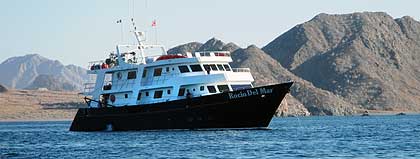
The Canon PowerShot D20 turned out to be a handy, unobtrusive companion for this type of salty, wet and occasionally wild exploring. We used the D20 as it was intended to be used, in the sand, on beaches, swimming, snorkeling, and diving.
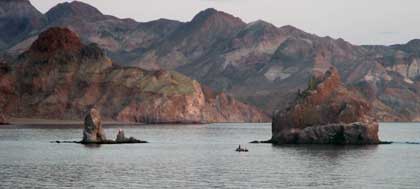
The Sea of Cortez itself (which the Mexican government officially renamed the Gulf of California) is about 800 miles long, between 30 and 150 miles wide, and has an average depth of almost 2,700 feet. Also known as the Islas Grandes, the eleven Midriff islands are located in the upper third of the Sea of Cortez. All are uninhabited and there's a haunting, stark beauty to them.
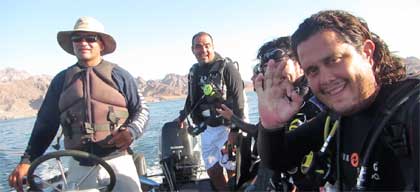
Due to currents, diving is off zodiacs. Good thing the D20 is completely waterproof. Now just to make this clear: most of our dives were deeper than the D20's 33 feet depth limit. We did take the D20 on a few of the shallower dives, where it did very well. But on this trip there was plenty more to see and take pictures off than just deep dives.

Like, for example, whale sharks. We swam and snorkeled with them in the Bahia de los Angeles, a coastal bay on the eastern shore of Baja California. The almost fully enclosed bay is part of a biosphere reserve, and we came here to see whale sharks. Whale sharks are filter feeders and the largest living fish on the planet. They can be over 40 feet in length, weigh almost 40 tons, and go back some 60 million years. They pose no danger to divers and snorkelers, and they can be observed as they are slow swimmers. The picture below was taken with the PowerShot D20, and we also took D20 HD video of the sharks.
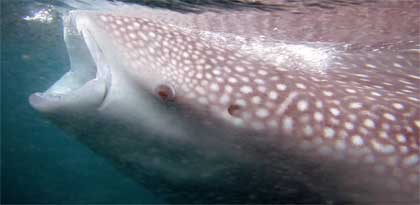
The D20 was also perfect to get close to some of the sea lion colonies. The pups are friendly and playful, but you have to watch out for the big males.
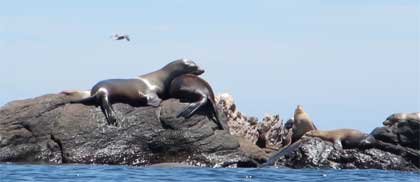
Taking pictures underwater is very different from taking pictures on dry land. Underwater you don't have time to agonize over settings, study manuals, or spend a lot of time trying to figure things out. Taking pictures must be easy and intuitive, and the Canon D20 certainly came through for us. It was easy to switch between normal and macro (or infinity), it was easy to set the flash, and the Canon quickly locked on with a green rectangle, ready to shoot (though underwater it is sometimes difficult to distinguish between a green and a yellow rectangle). We didn't have very clear water on this trip, and there was plenty of krill, so none of those luscious blue lagoon shots.
Below is the computer log of a dive with the Canon D20. For the most part of the one-hour dive we photographed at 30-35 feet. We hit 40 feet on a few occasions and the Canon D20 easily handled that. That's where the buttons on some of the Canon's competitors (which we also tested) stopped functioning. No such problems here.
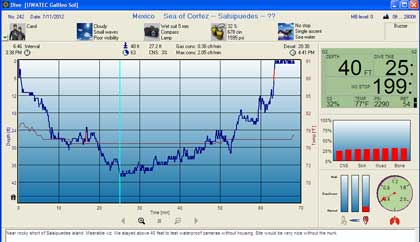
How well did Canon hit the mark with the D20?
This being only Canon's second entry into the rugged/waterproof digital camera market, how well did the PowerShot D20 hit the mark?
On the plus side...
- Finally a follow-up. It's been three years since the D10 was introduced, competitors have introduced whole generations of waterproof cameras, and so it's good to see Canon finally launch a follow-up to the D10. While the two overlap to some extent and the D10 remains available, it's clear that the present and future belongs to the D20. It's a nicely designed, competent and trust-inspiring camera with nice, large buttons that works well outdoors and in the water.
- A real dive camera. By "real" I mean you can take this camera on actual dives; it isn't limited to just snorkeling. Many dives are deeper, of course, but when you come upon a nice, shallow reef or a sand patch, it's great to be able to take a camera like the Powershot D20 along. It's just so handy.
- Even tougher than before. The D10 could handle 4-foot drops; this one can handle 5-foot drops. No one intends to drop a camera, but it can happen, and it's good to know the D20 can handle it. We also like the wide operating temperature range, which is likely even wider than Canon specifies as I'm pretty sure it can take pictures past its 104 degree fahrenheit maximum (hey, it gets up to 115 here where I live in central California).
- Folding 5X zoom. The biggest issue with the older D10 was that bulky dome for its measly 3X optical zoom. The D20's folding 5X zoom is so much better and no longer messes with the flash in macro shooting. Also very helpful is that the zoom starts wide at 28mm, which comes in handy in cramped spaces. And we appreciate the 1.5 and 2.0x digital teleconverter!
- Quality pictures. Picture quality was as good as we expected from a Canon, i.e. very good.
- HD video and video modes. The D10's 640 x 480 video doesn't cut it anymore today, and we greatly welcomed the D20's 720p and 1080p high definition modes. And the dedicated video button. And the extra slow motion modes. All good.
- Bright LCD. The very bright 3.0-inch hi-res display with its anti-reflection and scratch-resistant coatings and wide viewing angle is a good choice for an outdoor and underwater camera.
- Underwater shooting modes. Canon also gave the D20 two special underwater shooting modes as well as a special underwater white balance. This is important as taking pictures underwater is VERY different from shooting on dry land. Water progressively filters out certain colors (first red, then orange, etc.) which is why underwater pictures tend to look all blueish and greenish with little other color. There's also a lot of stuff floating around, making it very difficult for the camera to focus. Good underwater modes and special white balance settings can make for much better pictures underwater. But that's not all: the special 11-step blue to amber adjustment is invaluable that approximates color filters is terrific!
- Quick and handy. The camera locks onto subjects very quickly. This is important underwater where things (and the diver) tend to move around a lot. Switching between macro/normal/infinity was quick and easy, and so was switching between flash modes.
- Housing available. For deeper dives, Canon offers the optional WP-DC45 deepwater case.
Things we weren't so crazy about...
- Button confusion. The D20 has the on/off, shutter and replay buttons on top of the camera, side by side. True, the shutter is a bit larger and it's chrome, but you don't feel that when diving (or in many other situations). So we turned the camera off by mistake far too many times. Which is bad enough when you're trying to capture a fleeting subject, but compounding the issue is that once turned off, our D20 then wouldn't turn back on for over 20 seconds!
- 1080p video speed. Not to be ungrateful, but while theater movies are played back in 24 frames per seconds, the standard for vidcams is 30 frames per second or more. So the 1080p video looked just a little off.
- Features choice. We appreciated that Canon made a great effort to make shooting as simple as possible, with the camera figuring out what settings and modes to use. But, given that the D20 is a tough outdoors and underwater camera, why include so many playful modes and features that have nothing to do with outdoors? Toy camera mode? Color swaps? Poster effect? Fake fish-eye? Miniature effect? Blink activation? These are not issues outdoorsmen and divers worry about. Instead, the big issues are color compensation, backscatter avoidance, and autofocus that isn't distracted by flotsam and sediment. And, while not essential, a depth gauge/manometer would come in handy.
- Latch. The plastic latch of the battery/memory card compartment's sealed door looks more trust-inspiring than the D10's, but it is a real fingernail breaker.
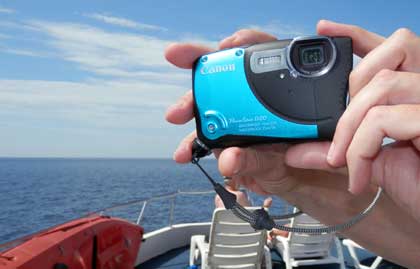
Bottom line: Canon PowerShot D20
The PowerShot D20 is Canon's second entry into the waterproof/rugged camera space where it joins offerings from the likes of Pentax, Nikon, Panasonic, Fujifilm and a number of specialty manufacturers. The eye-catchingly styled camera is perhaps a bit larger than we'd like, but is also well equipped to handle most of the abuse it may encounter outdoors. It can be used in freezing weather (down to 14 degrees Fahrenheit), it is dust and waterproof, and it can handle being dropped from up to five feet.
Divers can take it down to 33 feet of depth, enough for many scuba adventures. Our scuba testing was at a 40-foot divesite and we were underwater for an hour. The camera was very easy to operate and locked on quicker than most. We do wish, though, that the on/off button would not be located right next to the shutter.
720p and 1080p high definition video modes greatly add to the usefulness of this camera, as do special underwater modes and white balance settings and adjustments.
The D20 has a bright and vibrant 3.0-inch LCD display with anti-reflection and scratch-resistant treatment. The camera's controls are large and arranged so you can operate it with a glove. The 28-140mm equivalent 5X optical zoom works great underwater where wide angle shooting is almost mandatory. Optical lens stabilization very effectively reduces blur.
The list price of US$349 is relatively high, though in line with the rugged/waterproof competition.
We like:
- Great tough camera: waterproof to 33 feet, dustproof, can shoot in freezing weather
- Very easy to handle underwater
- 720p and 1080p HD video
- Bright, high-res anti-reflective 3.0-inch wide viewing-angle LCD
- Very effective sensor shift shake reduction
- Large and well marked controls
- Two underwater modes, custom underwater white balance
- Good picture quality
- 5X optical zoom that starts wide
- Deepwater housing available (WP-DC45)
Not so much:
- On/off button next to shutter makes it too easy to turn camera off by mistake
- When it goes off, camera won't turn back on for over 20 seconds
- Fairly large and heavy for a compact
- Battery compartment door latch a nail buster
- Feature set somewhat playful for a tough outdoor camera
See Canon's PowerShot D20 page.
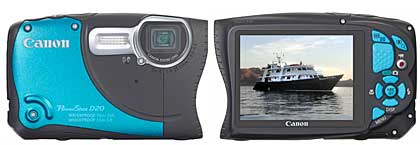
|










